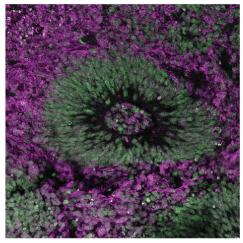Source: [Picower News | May 10, 2021]
Surprising findings can help improve organoid cultures, explain role of GSK3-beta in brain development
Like many around the world, the lab of Professor Mriganka Sur in The Picower Institute for Learning and Memory at MIT has embraced the young technology of cerebral organoids, or “minibrains,” for studying human brain development in health and disease. By making a surprising finding about a common practice in the process of growing the complex tissue cultures, the lab has produced both new guidance that can make the technology better, and also new insight into the important roles a prevalent enzyme takes in natural brain development.
To make organoids, scientists take skin cells from a donor, induce them to become stem cells and then culture those in a bioreactor, guiding their development with the addition of growth factors and other chemicals. Over the course of weeks, the stem cells become progenitor cells that multiply and then go on to become, or “differentiate” into, neurons or other brain cell types. Along the way the cells also migrate within the growing blob to take their places forming basic brain structures and circuits.
A beauty of organoids, therefore, is that as the cells in the culture grow and develop together, they simulate many of the basic processes that occur when real brains take shape. When cell donors have genes that cause disease, the organoid grown from their cells will reproduce underlying disease characteristics. The Sur lab uses organoids to study the abnormal brain development in Rett Syndrome, a devastating autism-like condition with a genetic underpinning.
A common practice among labs growing organoids is to improve the viability of the cells by adding a small molecule chemical called CHIR 99021 to inhibit the activity of a ubiquitous natural enzyme called GSK3-beta. In the new study in PLOS ONE the team led by Picower Fellow Chloé Delépine, confirmed that while different doses of CHIR 99021 can indeed keep cells alive, they have opposite effects on organoid growth – low doses promote growth but high doses constrain it and very high doses will stop it altogether. That information alone has obvious implications for labs using varying doses of CHIR 99021, but because Delépine’s team investigated how these growth effects occur, it also helps to clarify what GSK3-beta activity affects during brain development.
Above: Researchers tracked molecular markers of neural progenitor cells in organoids including one called PAX6, in green. Note that the middle organoid, which received a low dose of CHIR 99021, has more green staining and therefore more neural progenitor cells, than either the control organoid on the left or the high-dose organoid on the right.
It’s an important question. Other research groups, for instance, have shown that perturbations in a signaling pathway involving GSK3-beta in the brain are associated with schizophrenia and autism. The new findings model how varying levels of inhibition may affect development.

